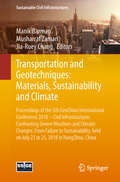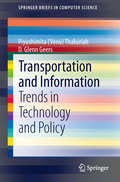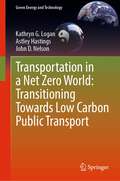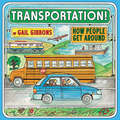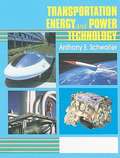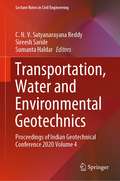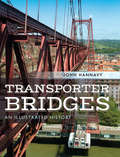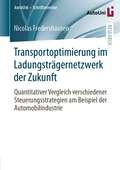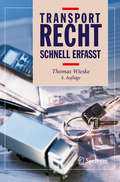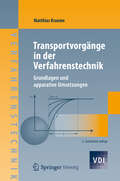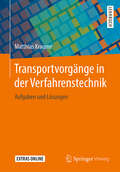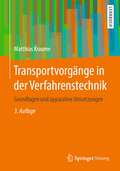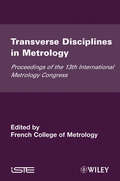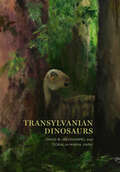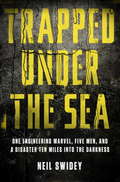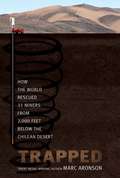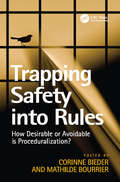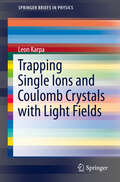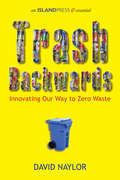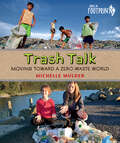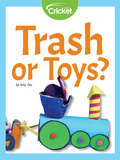- Table View
- List View
Transportation and Geotechniques: Proceedings of the 5th GeoChina International Conference 2018 – Civil Infrastructures Confronting Severe Weathers and Climate Changes: From Failure to Sustainability, held on July 23 to 25, 2018 in HangZhou, China (Sustainable Civil Infrastructures)
by Manik Barman Musharraf Zaman Jia-Ruey ChangThis book deals with the attempts made by the scientists, researchers and practitioners to address different emerging issues in transportation and geotechnical engineering. Papers focus on the following: (i) polymer-based dust suppressant,(ii) cement concrete materials, (iii) pavement preservation techniques, (iv) frost front in a cold-region circular tunnel, (v) metro station in non-cemented soil, (vi) seismic-liquefaction, (vii) mechanical responses of asphalt pavement at bridge approach, (viii) warm mix asphalt, and (ix) behavior of pile foundation. This volume is useful for the researchers and practitioners who work in the area transportation and geotechincal engineering. Papers were selected from the 5th GeoChina International Conference 2018 – Civil Infrastructures Confronting Severe Weathers and Climate Changes: From Failure to Sustainability, held on July 23 to 25, 2018 in HangZhou, China.
Transportation and Information
by D. Glenn Geers Piyushimita Vonu ThakuriahTransformations in wireless connectivity and location-aware technologies hold the promise of bringing a sea-change in the way transportation information is generated and used in the future. Sensors in the transportation system, when integrated with those in other sectors (for example, energy, utility and health) have the potential to foster novel new ways of improving livability and sustainability. The end-result of these developments has been somewhat contradictory. Although automation in the transportation environment has become increasingly widespread, the level of involvement and active participation by people, in terms of co-creation and contribution of information, has also increased. As a result, the following two major trends have been observed: (1) increases in Machine-to- Machine (M2M) communications; and (2) increases in the variety and volume of User-Generated Content. In this transportation paradigm, the pervasive use of Information and Communication Technologies will serve as the foundation for mobility intelligence towards an "ubiquitous information-centered mobility environment". However, many technical and operational questions, as well as social, management and legal challenges present themselves in the transformation to this vision. The book presents a non-technical review of research and initiatives and a discussion of such opportunities and challenges.
Transportation in a Net Zero World: Transitioning Towards Low Carbon Public Transport (Green Energy and Technology)
by John D. Nelson Astley Hastings Kathryn G. LoganThis book discusses the importance of transitioning from conventionally fuelled, electric and hydrogen personal vehicles towards low carbon electric and hydrogen public transport. It presents international comparisons and case studies of countries who have successfully and unsuccessfully implemented policies to reduce their emissions from land-based transport. It discusses and provides policy recommendations to meet a net zero transport world by exploring potential issues, including infrastructure changes and electricity generation mix which may prevent targets being met successfully. The book also demonstrates how the COVID-19 pandemic has influenced individual transport choices and what will need to be done to ensure travel remains sustainable going forward. Aligned with an active area of academic and civil discourse on the topic of sustainable transportation systems, Transportation in a Net Zero World will be of interest to researchers, policy makers, and graduate students alike, in the fields of environmental science and transport studies.
Transportation!: How People Get Around
by Gail GibbonsFrom cars and trains to planes and boats, people all around the world have developed diverse means and methods of travel. In this fascinating exploration of transportation, Gail Gibbons employs her signature, colorful artwork and accessible text to explain transportation choices to young readers. Vehicles of many kinds are clearly detailed, as are transportation-related facts and concepts such as carpooling and commuting. For young readers on the go, this book is a must-have!
Transportation, Energy, Power and Technology
by Anthony E. SchwallerWe live in a society that is reliant upon many forms of technology. These technologies give citizens choices for improving their lives. Transportation is one of the most important of these technologies. Transportation technology has become integrated into every part of our lives on a daily basis. Because of this, most citizens today take transportation technology for granted. Due to the increased ease of moving people and products, our society has changed considerably. We are a much more mobile and transient society. Today, millions of people, products, and goods are transported continuously to keep our economy and society running efficiently.
Transportation, Water and Environmental Geotechnics: Proceedings of Indian Geotechnical Conference 2020 Volume 4 (Lecture Notes in Civil Engineering #159)
by Sireesh Saride Sumanta Haldar C. N. V. Satyanarayana ReddyThis book comprises select proceedings of the Indian Geotechnical Conference 2020 (IGC2020) focusing on emerging opportunities and challenges in the field of transportation geotechnics, scour and erosion, offshore geotechnics, and environmental geotechnology. The contents will be useful to researchers, educators, practitioners and policy makers alike.
Transporter Bridges: An Illustrated History
by John HannavyThis volume of original and historic photographs captures the story of the ingenious bridges that carried us from the Victorian era into modern times.With their moveable platforms designed to traverse busy waterways, Transporter Bridges served a brief but vital need from the late 19th century into the early 20th. Though many were planned, the huge increase in road transport quickly rendered them obsolete. In the end, fewer than thirty were ever completed across the world, with only nine still standing in their original form. But the transporter bridge appears to be entering a renaissance. In France and Argentina, restoration efforts are bringing life back to some of the original bridges. Meanwhile, proposals exist for three new bridges across France—at Nantes, Marseille and Brest—to replace some of those lost during and after the Second World War.This illustrated history captures the beauty of transporter bridges through hundreds of color photographs. The author combines his own modern images with many historic photographs and postcards chronicling the construction and operation of these unusual structures.
Transportoptimierung im Ladungsträgernetzwerk der Zukunft: Quantitativer Vergleich verschiedener Steuerungsstrategien am Beispiel der Automobilindustrie (AutoUni – Schriftenreihe #169)
by Nicolas FredershausenDer Leerguttransportoptimierung als Teil der Inboundlogistik kommt die wichtige Aufgabe der bedarfs- und termingerechten Versorgung von Lieferanten mit wiederverwendbaren Ladungsträgern zu. Dadurch gewährleistet sie nicht nur eine reibungslose Teileversorgung, sondern kann auch einen signifikanten Beitrag zu einer effizienten und nachhaltigen Logistik im Ladungsträgernetzwerk der Zukunft leisten.Die vorliegende Arbeit widmet sich der Problemstellung der Leerguttransportoptimierung aus mathematischer Sicht und verfolgt das Ziel der Bestimmung eines bedarfserfüllungsmaximalen und gleichzeitig transportkostenminimalen Transportplans unter Berücksichtigung von Leergutverfügbarkeiten, -bedarfen, Transportkosten und -laufzeiten. Dafür werden drei verschiedene Steuerungsstrategien für das Ladungsträgernetzwerk der Zukunft vorgestellt und spezifische Konstruktions- und Verbesserungsheuristiken entwickelt. Anhand der Ergebnisse einer experimentellen Performanceanalyse wird eine Empfehlung für eine Steuerungsstrategie samt geeigneten Lösungsverfahren zur Transportoptimierung im Ladungsträgernetzwerk der Zukunft gegeben, die die Ziele der Bedarfserfüllungsmaximierung sowie Transportkosten- und Emissionsausstoßminimierung bestmöglich vereinen.
Transportrecht - Schnell erfasst: Schnell Erfasst (Recht - schnell erfasst)
by Thomas WieskeÜbersichtlich strukturiert und prägnant zusammengefasst, vermittelt der Band die Grundlagen des Transportrechts: vom deutschen Gütertransportrecht über das Speditions-, Umzugs- und Lagerrecht bis zu den internationalen Regelungen des Transportrechts. Die wichtigsten gesetzlichen Normen werden im Wortlaut vorgestellt, verständlich kommentiert und in Schaubildern und Übersichten zusammenfassend dargestellt. Auch die nationalen und internationalen Speditionsbedingungen finden Berücksichtigung.
Transportvorgänge in der Verfahrenstechnik
by Matthias KraumeTransportvorgänge spielen in verfahrenstechnischen Prozessen eine überragende Rolle. Für Ingenieure, technische Chemiker und Biotechnologen, die verfahrenstechnische Prozesse umsetzen wollen, ist ein fundamentales Verständnis der Transportvorgänge unverzichtbar. Das Buch beinhaltet sowohl die umfassende Darstellung der physikalischen Grundlagen als auch deren Anwendung in vielfältigen technischen Lösungen. Dabei werden diese Lösungen stets auf einfache Zusammenhänge zurückgeführt. Mit zahlreichen Übungsaufgaben zu praktischen Fragestellungen.
Transportvorgänge in der Verfahrenstechnik: Aufgaben und Lösungen
by Matthias KraumeTransportvorgänge spielen eine überragende Rolle in verfahrenstechnischen Prozessen, die in unterschiedlichen Industriezweigen – speziell in der chemischen, pharmazeutischen und der Lebensmittelindustrie sowie in der Biotechnologie – die Basis der Produktherstellung bilden. Das fundamentale Verständnis von Transportvorgängen ist eine unverzichtbare Voraussetzung für diejenigen, die diese in technischen Prozessen umsetzen. Dazu zählen vorrangig Ingenieure unterschiedlicher Fachdisziplinen, technische Chemiker und Biotechnologen. Als substanzielle Ergänzung des Lehrbuchs „Transportvorgänge in der Verfahrenstechnik“ wurde für die Lösungen der dortigen 200 Übungsaufgaben dieses Buch erstellt, in dem die Lösungswege ausführlich erläutert werden. Dies umfasst auch die Berechnung sämtlicher Zahlenwerte der Lösungen mittels Excel-Dateien, die als Zusatzmaterial in der Online-Version der jeweiligen Kapitel auf SpringerLink zur Verfügung stehen. Leserinnen und Leser können wahlweise die Aufgaben zunächst eigenständig lösen und anschließend überprüfen oder sich direkt mit den Lösungen in detaillierter Form auseinandersetzen. Auf diese Weise sollen sowohl die Kenntnisse als auch das methodische Wissen vertieft werden, um die Lösungskompetenz zur Behandlung eigener verfahrenstechnischer Fragestellungen zu erweitern.
Transportvorgänge in der Verfahrenstechnik: Grundlagen und apparative Umsetzungen
by Matthias KraumeTransportvorgänge spielen in verfahrenstechnischen Prozessen eine überragende Rolle. Für Ingenieure, technische Chemiker und Biotechnologen, die verfahrenstechnische Prozesse umsetzen wollen, ist ein fundamentales Verständnis der Transportvorgänge unverzichtbar. Das Buch beinhaltet sowohl die umfassende Darstellung der physikalischen Grundlagen als auch deren Anwendung in vielfältigen technischen Lösungen. Dabei werden diese Lösungen stets auf einfache Zusammenhänge zurückgeführt. Mit zahlreichen Übungsaufgaben zu praktischen Fragestellungen.
Transverse Disciplines in Metrology: Proceedings of the 13th International Metrology Congress, 2007 - Lille, France
by French College of MetrologyBased on The International Metrology Congress meeting, this reference examines the evolution of metrology, and its applications in industry, environment and safety, health and medicine, economy and quality, and new information and communication technologies; details the improvement of measurement procedures to guarantee the quality of products and processes; and discusses the development of metrology linked to innovating technologies. The themes of the Congress (quality and reliability of measurement, measurement uncertainties, calibration, verification, accreditation, sensory metrology, regulations and legal metrology) are developed either in a general way or applied to a specific economic sector or to a specific scientific field.
Transylvanian Dinosaurs
by Coralia-Maria Jianu David B WeishampelThe history and science of a cluster of dinosaurs found in the Hungarian region and the story of the aristocrat who discovered them.At the end of the time of the dinosaurs, Transylvania was an island in what was to become southeastern Europe. The island’s limited resources affected the size and life histories of its animals, resulting in a local dwarfism. For example, sauropods found on the island measured only six meters long, while their cousins elsewhere grew up to five times larger. Here, David B. Weishampel and Coralia-Maria Jianu present unique evolutionary interpretations of this phenomenon.The authors bring together the latest information on the fauna, flora, geology, and paleogeography of the region, casting these ancient reptiles in their phylogenetic, paleoecological, and evolutionary contexts. What the authors find is that Transylvanian dinosaurs experienced a range of unpredictable successes as they evolved.Woven throughout the detailed history and science of these diminutive dinosaurs is the fascinating story of the man who first discovered them, the mysterious twentieth-century paleontologist Franz Baron Nopcsa, whose name is synonymous with Transylvanian dinosaurs. Hailed by some as the father of paleobiology, it was Nopcsa alone who understood the importance of the dinosaur discoveries in Transylvania; their story cannot be told without recounting his.Transylvanian Dinosaurs strikes an engaging balance between biography and scientific treatise and is sure to capture the imagination of professional paleontologists and amateur dinophiles alike.“It is rare to find a book on dinosaurs so literate, well-written, and full of insight and synthesis—particularly when the dinosaurs are so unusual. The authors lay them out for us, situate them beautifully in time, space, and cultural history, and then reassemble them and their world using all the tools of modern science. The result is a tour de force.” —Kevin Padian, University of California Museum of Paleontology“A fine example of something I always try, but rarely succeed, to articulate to colleagues in paleontology, evolutionary biology, and geology who don’t work on dinosaurs. Dinosaurs, within the context of their ecosystems and paleogeography, can tell us many neat things about how evolution works over long time scales.” —Stephen Brusatte, Priscum
Trapped Under the Sea
by Neil SwideyThe harrowing story of five men who were sent into a dark, airless, miles-long tunnel, hundreds of feet below the ocean, to do a nearly impossible job--with deadly results A quarter-century ago, Boston had the dirtiest harbor in America. The city had been dumping sewage into it for generations, coating the seafloor with a layer of "black mayonnaise." Fisheries collapsed, wildlife fled, and locals referred to floating tampon applicators as "beach whistles." In the 1990s, work began on a state-of-the-art treatment plant and a 10-mile-long tunnel--its endpoint stretching farther from civilization than the earth's deepest ocean trench--to carry waste out of the harbor. With this impressive feat of engineering, Boston was poised to show the country how to rebound from environmental ruin. But when bad decisions and clashing corporations endangered the project, a team of commercial divers was sent on a perilous mission to rescue the stymied cleanup effort. Five divers went in; not all of them came out alive. Drawing on hundreds of interviews and thousands of documents collected over five years of reporting, award-winning writer Neil Swidey takes us deep into the lives of the divers, engineers, politicians, lawyers, and investigators involved in the tragedy and its aftermath, creating a taut, action-packed narrative. The climax comes just after the hard-partying DJ Gillis and his friend Billy Juse trade assignments as they head into the tunnel, sentencing one of them to death. An intimate portrait of the wreckage left in the wake of lives lost, the book--which Dennis Lehane calls "extraordinary" and compares with The Perfect Storm--is also a morality tale. What is the true cost of these large-scale construction projects, as designers and builders, emboldened by new technology and pressured to address a growing population's rapacious needs, push the limits of the possible? This is a story about human risk--how it is calculated, discounted, and transferred--and the institutional failures that can lead to catastrophe. Suspenseful yet humane, Trapped Under the Sea reminds us that behind every bridge, tower, and tunnel--behind the infrastructure that makes modern life possible--lies unsung bravery and extraordinary sacrifice. From the Hardcover edition.
Trapped: How the World Rescued 33 Miners from 2,000 Feet Below the Chilean Desert
by Marc AronsonThe amazing story of the trapped Chilean miners and their incredible rescue that Publishers Weekly calls "a riveting, in-depth recounting of the events that held the world rapt."In early August 2010, the unthinkable happened when a mine collapsed in Copiano, Chile, trapping 33 miners 2,000 feet below the surface. For sixty-nine days they lived on meager resources with increasingly poor air quality. When they were finally rescued, the world watched with rapt attention and rejoiced in the amazing spirit and determination of the miners. What could have been a terrible tragedy became an amazing story of survival. In Trapped, Marc Aronson provides the backstory behind the rescue. By tracing the psychological, physical, and environmental factors surrounding the mission, Aronson highlights the amazing technology and helping hands that made it all possible. From the Argentinean soccer players that hoped to raise morale, to NASA volunteering their expertise to come up with a plan, there was no shortage of enterprising spirit when it came to saving lives. Readers will especially appreciate the eight pages of full-color photos, timeline, glossary, notes, and more.
Trapped: How the World Rescued 33 Miners from 2,000 Feet below the Chilean Desert
by Marc AronsonIn early August 2010, the unthinkable happened when a mine collapsed in Copiapó, Chile, and 33 miners were trapped 2,000 feet below the surface. For sixty-nine days they lived on meager resources and increasingly poor air quality. When they were finally rescued, the world watched with rapt attention and rejoiced in the amazing spirit and determination of the miners. What could have been a terrible tragedy became an amazing story of survival. Now, with exclusive interviews with rescuers and expert commentary, Marc Aronson brings us the backstory behind this incredible event. By tracing the psychological, physical, and environmental factors surrounding the rescue, Trapped highlights the amazing technology and helping hands that made it all possible. From the Argentinean soccer players who hoped to raise morale, to NA SA volunteering their expertise to come up with a plan, there was no shortage of enterprising spirit when it came to saving lives.
Trapping Safety into Rules: How Desirable or Avoidable is Proceduralization?
by Mathilde BourrierRules and procedures are key features for a modern organization to function. It is no surprise to see them to be paramount in safety management. As some sociologists argue, routine and rule following is not always socially resented. It can bring people comfort and reduce anxieties of newness and uncertainty. Facing constant unexpected events entails fatigue and exhaustion. There is also no doubt that proceduralization and documented activities have brought progress, avoided recurrent mistakes and allowed for 'best practices' to be adopted. However, it seems that the exclusive and intensive use of procedures today is in fact a threat to new progress in safety. There is an urgent need to consider this issue because there is doubt that the path chosen by many hazardous industries and activities is the most effective, safety wise, considering the safety level achieved today. As soon as safety is involved, there seems to be an irresistible push towards a wider scope of norms, procedures and processes, whatever the context implied. This book is not a plea against proceduralization, but it does take the view that it is time to reassess how far it can still go and to what benefit. Underlying these questions, there is a growing suspicion that the path taken might in fact lead to a dead end, unless the concept of procedure and the conditions under which these procedures are developed are revisited.
Trapping Single Ions and Coulomb Crystals with Light Fields (SpringerBriefs in Physics)
by Leon KarpaThis book describes the state-of-the-art in the emerging field of optical trapping of ions, as well as the most recent advances enabling the use of this technique as a versatile tool for novel investigations in atomic physics. The text provides a detailed explanation of the requirements for optical trapping of ions, replete with a protocol for optical ion trapping, including preparation, transfer, and detection. The book also highlights the experimental requirements for extending the presented scheme to optical trapping of linear ion chains. Lastly, this text elaborates on the key features of the described approach, such as the capability to arrange single strongly interacting atoms in scalable, state-selective and wavelength-sized optical potentials without the detrimental impact of driven radiofrequency fields conventionally used to trap ions. The described results demonstrate that the developed methods are suitable for new experimental investigations, most notably in the field of ultracold interaction of ions and atoms, but also in quantum simulations and metrology. The book's practical bent is perfect for anyone attempting to build an experiment related to the field or understand the limitations behind current experiments.
Trash Backwards: Innovating Our Way to Zero Waste (Island Press E-ssentials)
by David NaylorTrash Backwards: Innovating Our Way to Zero Waste examines the various kinds of trash Americans are producing in staggering quantities, and profiles a range of innovative processes, people, and companies who are thinking creatively about how to not just reduce pressure on landfills, but redefine what's possible in the realm of recycling. This E-ssential offers insights into the motivations and inspirations of people working on cutting edge processes of waste management and land reclamation in America--from household trash to biowaste processing to reclaiming brownfields. We're at a critical juncture with our waste production-- and among all of the other problems on Earth (climate change, war, stagnant economies), this is the one that ingenuity, as well as a little old-fashioned conservation, can put a big dent in, if not solve.
Trash Day (Fountas & Pinnell LLI Red #Level M)
by Claire DanielCedric makes an incredible discovery on trash day - a robot! His new helper can clean Cedric's room and do his homework. Unfortunately, that's not all it can do.
Trash Talk: Moving Toward a Zero-Waste World (Orca Footprints #6)
by Michelle MulderHumans have always generated garbage, whether it's a chewed-on bone or a broken cell phone. Our landfills are overflowing, but with some creative thinking, stuff we once threw away can become a collection of valuable resources just waiting to be harvested. Trash Talk digs deep into the history of garbage, from Minoan trash pits to the Great Pacific Garbage Patch, and uncovers some of the many innovative ways people all over the world are dealing with waste.
Trash or Toys?
by Amy TaoReusing your trash to make toys can be lots of fun–and decrease pollution and waste! Things we use around the house get old and we throw them away. What if you use them to make toys or gadgets that make life better? Experts think reusing things may be better than recycling! Learn how to make a piggy bank from a plastic can or a train with egg cartons. What things can you create by reusing?
Trash or Treasure: Entrepreneurial Opportunities in Waste Management
by Pardeep Singh Anwesha BorthakurIn this book, we have contributions from experts working on diverse aspects of waste management and waste entrepreneurship with an aim to contribute toward a holistic understanding of the existing and forthcoming waste handling challenges. Waste entrepreneurship refers to the practice of creating and operating businesses that aim to address the problem of waste management. It signifies businesses that are dedicated to finding innovative solutions for managing waste and plays a crucial role in building a sustainable future. Waste entrepreneurs identify waste as a valuable resource and use state-of-the-art tactics to reduce, reuse, recycle, and re-purpose it. By developing new technologies, services, and products that help reduce waste and recycle materials, they can create new economic opportunities while simultaneously reducing the environmental impact of waste. The primary audience of this book are researchers (from a wide range of disciplinary backgrounds) working in the field of waste management (especially E-waste, Plastics, Paper and Cardboard Waste, Organic Waste, and Construction and Demolition Waste) and environmental sustainability. This book also contains descriptions of various facets of waste entrepreneurship from different countries which will be helpful for different entrepreneurs looking for business opportunities in the waste management sector, NGOs, government agencies, international agencies, and new researchers working in the related fields. In particular, the book could provide start-up ideas to the enthusiastic readers.
Trauma-Biomechanik: Einführung in die Biomechanik von Verletzungen (VDI-Buch)
by Kai-Uwe Schmitt Peter F. Niederer Duane S. Cronin Markus H. Muser Felix WalzTrauma-Biomechanik untersucht die Reaktion und Toleranz des menschlichen Körpers auf mechanische Belastungen, die zu Verletzungen führen können. Dabei ist das Verständnis der mechanischen Faktoren, die einen Einfluss auf die Funktionsfähigkeit und die Struktur des Gewebes haben, entscheidend, um Gegenmaßnahmen zur Minderung oder Verhinderung von Verletzungen zu entwickeln.Die Trauma-Biomechanik deckt ein weites Spektrum an Fragestellungen bezüglich Verletzungen ab; namentlich die Klassifikation von Verletzungen, die Verletzungs-Mechanismen und die bekannten Verletzungs-Kriterien. Dieses Buch stellt diese biomechanischen Grundlagen und deren Anwendungen dar. Es behandelt Verletzungen, die im Strassenverkehr und Sport erlitten werden, und geht zudem auf Verletzungen ein, die durch den Einfluss hoher Energien entstehen. Das Buch bietet eine kompakte Darstellung von der Anatomie bis zu ingenieurwissenschaftlichen Ansätzen zur Verletzungsprävention. Dabei wird der in diesem Fachgebiet zweckmässige interdisziplinäre Ansatz verdeutlicht.
